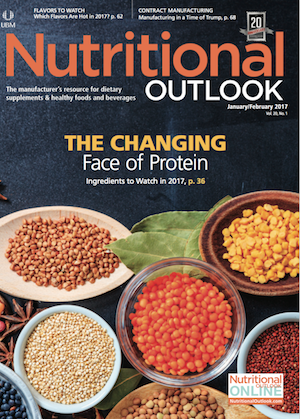2017 Ingredient Trends to Watch for Food, Drinks, and Dietary Supplements: Vitamin B12
“Energy” has now moved ahead as the number-two reason why Americans who use dietary supplements say they take supplements in the first place, so it’s not surprising to see sales of vitamin B12 growing in all retail channels.
Photo © Shutterstock.com/NatchaS

“Energy” has now moved ahead as the number-two reason why Americans who use dietary supplements say they take supplements in the first place, according to the Council for Responsible Nutrition’s (CRN; Washington, DC) 2016 Consumer Survey on Dietary Supplements. It’s not surprising, then, to see sales of vitamin B12, a nutrient consumers popularly seek for energy support and integral to daily cellular activity, growing in all retail channels that SPINS tracks: 7.4% in the multi-outlet channel (to $154 million), 14.2% in natural channel (to $14 million), and 3.9% in the specialty-gourmet channel (to $913,000).[1]
“Consumers see B12 as a source for energy, and this has been a compelling message driving the category as people look for tools to help them keep up with the pace of modern life,” says Rory Lipsky, senior director of business strategy for supplements brand Jarrow Formulas. Lipsky says that interest in his company’s B12 products continues to grow. “B12 has been on a major growth trajectory for the last several years at Jarrow Formulas, and we see this trend continuing in 2017.”
Older adults are especially at risk of low B12 levels, says Duffy MacKay, ND, CRN’s senior vice president of scientific and regulatory affairs. “The 2010 Dietary Guidelines for Americans identified vitamin B12 as a nutrient of concern for Americans ages 50 years and older,” he says. “It is not because individuals age 50 years and older do not consume adequate vitamin B12; it is because a substantial proportion of this population may have impaired ability to absorb vitamin B12.” The Dietary Guidelines for Americans encourage these individuals to eat foods containing B12 (such as fortified cereals) or to take B12 supplements, MacKay says. Jarrow’s Lipsky adds that more consumers overall are learning about the absorption differences between B12 forms and that he sees more consumers moving toward the methylcobalamin form, which “exhibits faster and more reliable uptake than cyanocobalamin.”
Those following a plant-based diet may also find themselves with lower-than-needed B12 levels. Kimberly Kawa, natural products specialist for SPINS, says she wonders “if with the heightened focus around whole foods, flexitarian, and plant-based diets, more consumers will look into B12 supplementation, especially when there is a dramatic decrease in meat consumption and if a health practitioner makes a recommendation due to this.” Already, she says, B12 supplements labeled as “vegan” saw double-digit gains last year, although she notes that this market is still relatively small.
Others who may be deficient in B12 or who may benefit from B12 supplementation include those with Alzheimer’s disease and those with diabetic neuropathy, says Lipsky. There is growing interest in B12’s benefits in areas of health such as the brain and nervous system, immune function and inflammation, and bone and joint health. SPINS points to growing sales for B12 in the heart-health and brain-health categories-albeit these are still much smaller markets for B12 than energy support.
According to Lipsky, based on Jarrow’s sales, standalone vitamin B12 supplements are most popular (with growing interest in chewable tablets), followed by B12 in combination formulas, such as with 5-methylfolate and other B vitamins. SPINS also says that single-ingredient B12 supplements decisively outperformed multi-ingredient formulas last year. It adds that B12 sales are growing in shelf-stable energy and functional beverages.
According to Lipsky, one possible challenge for B12 in 2017 is if raw-material prices continue to rise as they have been. “This could make products more expensive and potentially slow the pace of sales growth,” he says. Overall, however, B12 supplementation will continue to be important to those who need energy support and to those who know they are deficient in this nutrient. With most demand coming from those two camps, and with energy an increasingly high priority for Americans of all ages, we expect lively activity for B12 in 2017.
Also read:
Natural Ingredients for Energy Dietary Supplements
Energy Drink Trends: Less Sugar, Clean Label, Natural, and More
Energy Is Number-Two Priority Among Supplement Users, 2016 CRN Survey Suggests
2017 Ingredient Trends to Watch for Food, Drinks, and Dietary Supplements:
Plant Protein vs. Dairy Protein
Hemp CBD, Vinpocetine, and Kratom
Jennifer Grebow
Editor-in-Chief
Nutritional Outlook magazine
jennifer.grebow@ubm.com
References:
[1] Sales numbers courtesy of SPINS, covering the 52 weeks ending November 27, 2016.

Prinova acquires Aplinova to further increase its footprint in Latin America
April 7th 2025Prinova has recently announced the acquisition of Brazilian ingredients distributor Aplinova, which is a provider of specialty ingredients for a range of market segments that include food, beverage, supplements, and personal care.

























